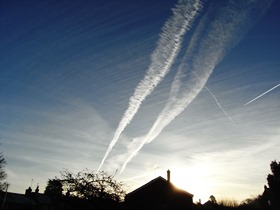Re-routing flights could reduce climate impact of vapour trails
Release Date 19 June 2014

Aircraft can become more environmentally friendly by choosing flight paths that reduce the formation of their distinctive condensation trails, new research suggests.
In a study published today, 19 June 2014, in IOP Publishing's journal Environmental Research Letters, researchers from the University of Reading have shown that aircraft contribute less to global warming by avoiding the places where the thinly shaped clouds, called contrails, are produced - even if that means flying further and emitting more carbon dioxide.
Contrails only form in regions of the sky where the air is very cold and moist, which is often in the ascending air around high pressure systems. They can sometimes stay in the air for many hours, eventually spreading out to resemble natural, wispy clouds.
The findings suggest that policymakers need to consider more than carbon emissions in discussions about how to make aviation less environmentally damaging. Recent research has shown that the amount of global warming caused by contrails could be as large, or even larger, that the contribution from aviation CO2 emissions.
The work was carried out by Dr Emma Irvine, Professor Keith Shine, and Professor Sir Brian Hoskins, at the Department of Meteorology at the University of Reading.
Dr Irvine said: "If we can predict the regions where contrails will form, it may be possible to mitigate their effect by routing aircraft to avoid them.
"Our work shows that for a rounded assessment of the environmental impact of aviation, more needs to be considered than just the carbon emissions of aircraft."
Just like natural clouds, contrails reflect some of the Sun's incoming energy, resulting in a cooling effect, but also trap some of the infrared energy that radiates from Earth into space, therefore having a warming effect. Detailed calculations indicate that generally the warming effect wins over the cooling effect.
The researchers estimate that smaller aircraft can fly much further to avoid forming contrails than larger aircraft. For example, for a small aircraft that is predicted to form a contrail 20 miles long, if an alternative route adds less than 200 miles onto the route (i.e. 10 times the length of contrail that would have been produced) then the alternative route would have a smaller climate impact.
For larger aircraft, which emit more CO2 than smaller aircraft for each mile flown, the alternative route could still be preferable, but only if it added less than 60 miles (i.e. 3 times the contrail length) onto the route.
Dr Irvine added: "Comparing the relative climate impacts of CO2 and contrails is not trivial. One complicating factor is their vastly differing lifetimes. Contrails may last for several hours, whilst CO2 can last for decades. In terms of mitigating these impacts, air traffic control agencies would need to consider whether such flight-by-flight re-routing is feasible and safe, and weather forecasters would need to establish if they can reliably predict when and where contrails are likely to form.
"The mitigation targets currently adopted by governments all around the world do not yet address the important non-CO2 climate impacts of aviation, such as contrails, which may cause a climate impact as large, or even larger, than the climate impact of aviation CO2 emissions.
"We believe it is important for scientists to assess the overall impact of aviation and the robustness of any proposed mitigation measures in order to inform policy decisions. Our work is one step along this road."
Fast Facts
- Aviation CO2 emissions accounted for 6% of UK total greenhouse gas emissions in 2011.
- Global CO2 emissions from aviation were estimated at 630 million tonnes of CO2 for 2005. This is 2.1% of the global emissions of CO2 in that year.
- Previous research by scientists at the University of Reading has shown that, on average, 7% of the total distance flown by aircraft is in cold, moist air where long-lasting contrails can form (2.4 billion km out of a global total of 33 billion km flown in 2005).
- Aircraft engines emit a number of other gases and particles that can alter climate (such as oxides of nitrogen and sulphur gases) and their effects might also depend on the route taken.
Full reference: E A Irvine, B J Hoskins and K P Shine (2014) ‘A simple framework for assessing the trade-off between the climate impact of aviation carbon dioxide emissions and contrails for a single flight' Environ. Res. Lett. 9 064021
The paper can be downloaded here
